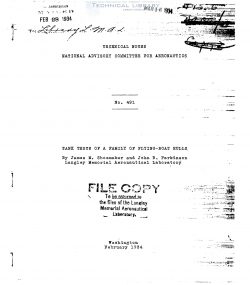naca-tn-491
- Version
- 153 Downloads
- 1.34 MB File Size
- 1 File Count
- November 25, 2016 Create Date
- November 25, 2016 Last Updated
National Advisory Committee for Aeronautics, Technical Notes - Tank Tests of Auxiliary Vanes as a Substitute of Flying Boat Hulls

This report presents towing tests made in the N. A. C. A.
tank of a parent form and five .variations of a flying—boat
hull. The beams of two of the derived forms were made the
same as that of the parent and the lengths changed by in—
creasing_and decreasing the spacing of stations. The
lengths of two others of the derived forms were made the
same as that of the parent while the beams were Changed
by increasing and decreasing the spacing of buttocks, all
other widths being changed in preportion. The remaining a
derived form has the same length and beam as the parent,
but the lines of the forebody were altered to give a plan~
ing bottom with no longitudinal curvature forward of the
step.
The test data were analyzed to determine the minimum
resistance and the angle at which it occurs for all speeds
and loads. The results of this analysis are given in the
form of nondimensional curves for each model.
The effect of variation in over—all size, as indi—
cated by a "complete" test on any given hull, is pointed
out. The effect of changing length alone by the spacing—*
of stations, of changing beam alone by the.spacing of but—
tocks, as well as the effects of the changes in length-
beam ratio and long_itudinal curvature that result from .
these Operations are discussed. The difficulties encoun—
tered in int_erpreting test results of systematic families
derived by the method used are emphasized. Further stud-
ice are suggested in which changes in the variable under
consideration would net be ohscnred by secondary changes
in other important variables.
The effects of changes in hull dimensions and shape
of under-water volume for displacement—type vessels have
been extensively investigated in towing tanks. Systematic
series of models based upon single sets of lines with pro—
gressive changes in the factors that affect resistance
have “been of great assistance in developing more efficient
forms.
Similar methods suggest themselves for towing tank
research conducted for the purpose of improving the .water
performance of. seaplanes. The different character. of sea-
plane_hull operation! however, leads to dissimilarities in
the factors that affect resistance. During the takevoff,
the speed increases from zero to the point at which flight
is attained; the load on the water decreases .as the load
is transferred from the water to the_ Kings and, 'for the
greats}_ part of the take-off.
| File | Action |
|---|---|
| naca-tn-491 Tank Tests of Auxiliary Vanes as a Substitute of Flying Boat Hulls.pdf | Download |
Comment On This Post